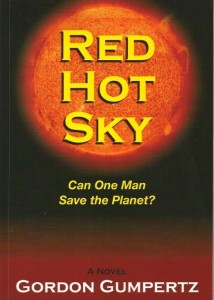 Today, I’m happy to welcome Gordon Gumpertz, author of Red Hot Sky, with an interesting point about life on our little planet.
Today, I’m happy to welcome Gordon Gumpertz, author of Red Hot Sky, with an interesting point about life on our little planet.
Escape to a New Planet
By Gordon Gumpertz
Coffee, tea, or milk? What would you order if you had to sit in coach class for 20 years while your starship raced through outer space at the speed of light? That’s how long it would take to reach the nearest planet discovered so far that may have an atmosphere that could support human life. That is, if man someday develops the technology to transport people at the speed of light (about 300 million miles per second).The planet called Gliese 581d has 6 times the mass of earth, and lies within its star’s habitable zone which could mean a temperate climate and, hopefully, air and water. If the human race is to survive beyond a billion years from now, such a trip will be necessary.
Those of us living on planet earth today are a lucky bunch. We are about midway between our sun’s origin 4.7 billion years ago, and its likely demise 5 billion years hence. It is a time when the temperature range and availability of water make it possible for earth to support a flourishing animal and plant life.
It was not always so. Scientists believe our earth was formed about 4.5 billion years ago from the same space dust and gasses that formed the sun. But the sun was too cool to support life until a billion years ago, when it became strong enough to allow life to begin developing. In another 5 billion years the sun will begin its transformation into a red giant, the phase of a star’s life when it runs out of hydrogen fuel and expands before its core finally collapses and the star contracts into a cool, white dwarf. However, long before the transition to red giant begins, earth will gradually become too hot to support life. Water, including the oceans, will evaporate and earth will become an uninhabitable desert. Some scientists estimate that phase could come as early as 1.4 billion years from now.
Will the human race be able to escape its fate by relocating to another planet? NASA’s Kepler satellite telescope has been searching outer space for evidence of planets orbiting other stars. Kepler has already identified hundreds of such planetary bodies, but so far only a few of those seem to be located in the so-called Goldilocks zone — the right distance from its star to have the temperature range that could support life. The composition of these planets is not known, and whether or not they have air and water is not known. Even if the perfect planet were discovered, could mankind ever develop the technology to safely transport human beings millions of light years through space?
Here on this earth, it’s true that we have to cope with earthquakes, volcanoes, tsunamis, floods, fires, drought, and dozens of other natural and manmade disasters. Plus disease and life’s many challenges. But we are nevertheless fortunate to live on a planet under a warming sun, with the air, water, and soil that makes it possible for life to flourish. Wouldn’t it be great if the nations, races, religions, tribes, and clans on earth, large and small, could settle their differences and concentrate on making our special planet a better place for all.
 Gordon Gumpertz brings fiction readers another exciting action/adventure experience in his new novel RED HOT SKY. This is the author’s second book, following his highly acclaimed novel TSUNAMI.
Gordon Gumpertz brings fiction readers another exciting action/adventure experience in his new novel RED HOT SKY. This is the author’s second book, following his highly acclaimed novel TSUNAMI.
In addition to writing novels, Gordon has won gold and silver awards in national and regional short story competitions. He is a member of the Authors Guild, the Palm Springs Writers Guild, a UCLA graduate, and an instrument-rated private pilot. He keeps his website current by blogging on natural disasters and natural phenomena.
Gordon and his wife Jenny live not far from the San Andreas fault, where the Pacific Plate thrusts into the North American Plate, building increasingly high levels of faultline stress which, the seismologists say, may soon produce the Big One.
Visit his website at www.tsunaminaturaldisaster.com.
Website | Amazon | Amazon Kindle | Barnes & Noble | Smashwords
Beautiful post. We sure do take things for granted, don’t we? Isn’t it hard to imagine the earth as it is now won’t be here forever? Fantastic post, Gordon and thank you for hosting him today, Carol!
This is quite the guest post. I had no idea it would take 20 years to reach the nearest inhabitable planet.
It is true, if only we could put aside our differences and make the world a better place. Red Hot Sky sounds like an interesting read.
It’s good to see, though, when a major disaster strikes, how different people, and different countries for that matter, can pull together.